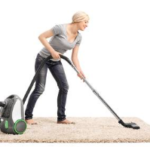- Views504
- Likes0
The primary objective of vacuuming is to remove soil from the carpet before it can cause permanent damage and discoloration
Vacuum cleaners have change dramatically since the first electric vacuum was invented in 1890. The purpose, however, has remained the same: to remove soil debris and dust. With synthetic fibers, it is very important that regular and complete cleaning are provided. The goal is to maintain high levels of appearance and sanitation over a period of years.
Why do we Vacuum?
- Appearance : Vacuuming helps keep carpets looking neat and clean by removing dust and soil particles that can cause permanent discoloration and damage.
- Prolong the carpet life : Regular vacuuming removes sharp, gritty particles that can cut and scratch the carpet fibers. These scratches weaken the fibers and hold soils that can cause discoloration. Regular Vacuuming can prolong the periods between comple cleaning, which can also damage the fibers.
- Sanitation/Improved Air Quality : Vacuuming removes materials that may aggravate allergies, asthma, and other breathing problems as well as disease-causing bacteria.
- Safety : While vacuuming any damage will be immediately noted and repairs can then be taken care of it before additional damage is done or someone is possible injured.
As carpet cleaners we will undoubtedly be mainly concerned with the first item: APPEARANCE.
Vacuuming Schedule
When outlining a vacuuming program or schedule there are a number of variables that must be  considered. The main factor is need and the needs of an area will be determined by,
considered. The main factor is need and the needs of an area will be determined by,
- The type and amount of use. (Traffic)
- The construction and fiber.
- The type of vacuuming equipment used.
- The level of appearance and sanitation desired.
General Rule:
- The more traffic and use, the more vacuuming and cleaning is needed.
- Heavy traffic lanes and high-usage areas(primary areas) should be vacuumed on a daily basis.
- Light traffic areas,(secondary areas) a quick spot vacuuming to clean traffic lanes, may be all that is required, on a daily or twice-weekly basis
A complete vacuuming of all carpeted surfaces using an upright vacuum cleaner with a rotating beater brush should be scheduled weekly.
A rotating schedule for complete vacuuming of specific areas on a daily basis may require when caring for facilities with a lot of carpeted areas.
Traffic Lane Vacuuming
A standard suction type vacuum(Cannister type dry vacuum) is the very effective, lightweight, and easy to maneuver. Vacuuming should be done daily to prevent dirt and soil from working down into the fibers. Generally concentrating on entrances and other high-usage areas.
Vacuuming can best be accomplished by using strokes 3-4 feet long. This will depend on the operator and the available space. For more thorough vacuuming, you may take additional passes over each area from the opposite direction.
The following checklist can help you when vacuuming traffic lanes
| Traffic Lane Vacuuming |
| – Collect all required equipment and attachments and go to the work area |
| – Plug in the vacuum in near the end of the area or near the entrance of the office. |
| – Place the vacuum in a central location. |
| – Work in a comfortable position facing the floor attachment. |
| – Keep the floor attachment flat on the surface of the carpet. |
| – Make several passes over each area. |
| – Do not bump walls, furniture, corners or equipment with this vacuum or its attachments. |
Complete Vacuuming
The process of vacuuming an entire carpeted area. This includes vacuuming under chairs, tables, desks, and any other easily moved items as well as all edges and behind doors.
Upright vacuums with a beater bar rotating brush is the most effective for complete vacuuming. Cannister type vacuums may be faster and more versatile, in that they come with a variety of accessories for different applications.
The following checklist can help you when complete vacuuming is required.
| Complete Vacuuming |
| – Collect all required equipment and attachments and go to the work area. |
| – Plug in the vacuum in near the end of the area or near the entrance of the office. |
| – Vacuuming around the room in a clockwise or, counterclockwise direction. |
| – All edges and areas around and behind furniture should be vacuumed. |
| – Vacuum under tables, desks, chairs, anything movable, if applicable. |
| – Make two or three passes over each area, depending on soil conditions. |
| – Return all furniture to its original position after vacuuming. |
| – Work in a comfortable position facing the floor attachment. |
| – Keep the floor attachment flat on the surface of the carpet. |
| – Do not bump walls, furniture, corners or equipment with this vacuum or its attachments. |
Note:
- Do not unplug computers, fax machines, or any electrical equipment.
- Make a note of spots for removal.
Remember:
- Hard to reach areas, such as behind desks and filing cabinets, should be scheduled.
- Paper clips and staples, should be removed before any vacuuming is started.
- Do any required edging prior to beginning vacuuming of each area.
- Dont jerk the cord, unplug it.

I like to vacuum at least twice a week. No need for expensive vacuums, my little blue bissell does everything for me.